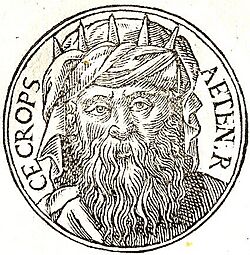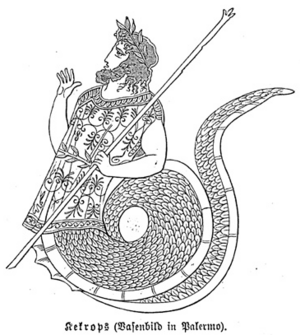Cecrops I facts for kids
Quick facts for kids Cecrops |
|
|---|---|
| King of Cecropia (i.e. Athens) | |

Cecrops I from Promptuarii Iconum Insigniorum
|
|
| Predecessor | Actaeus |
| Successor | Cranaus |
| Abode | Athens |
| Personal information | |
| Consort | Aglaurus |
| Offspring | Erysichthon, Aglaurus, Herse, Pandrosus |
| Parents | autochthon |
| Siblings | - |
Cecrops was a legendary king from ancient Attica, a region in Greece. He is often called the first king and founder of the famous city of Athens. Before his time, the region was known as Acte or Actice. It was renamed Cecropia after him. Cecrops is seen as a "culture hero" because he taught the people of Athens many important skills. These included how to get married, how to read and write, and how to bury their dead properly.
Contents
Who Was Cecrops?
His Strange Form
Ancient stories say that Cecrops was born directly from the earth itself. This is why he was called an autochthon, which means "native" or "born from the land." He was also described as having a very unusual appearance. His top half looked like a man, but his bottom half was shaped like a serpent or a fish tail. Because of this, he was known as diphuḗs, meaning "of two natures." Some ancient writers thought this double form meant he had two types of citizenship, both Greek and non-Greek. Others believed it referred to marriage, which he was said to have started.
Cecrops' Family
Cecrops married Aglaurus, who was the daughter of Actaeus. Actaeus was the previous king of Attica, and Cecrops took over the throne after him. Cecrops had a son named Erysichthon. However, Erysichthon died before his father. After Cecrops, the next king was Cranaus, who was known as one of the richest people in Athens.
Cecrops also had three daughters: Herse, Pandrosus, and Aglaurus. A famous myth tells how the goddess Athena gave them a special box or jar. Inside was the baby Erichthonius, and they were told not to look inside. But they couldn't resist! When they opened it, they saw two serpents that Athena had placed there to guard the child. Terrified, the sisters fled in fear and died. Some stories say one of the sisters was turned to stone instead.
Cecrops' Impact on Society
Bringing Civilization to Athens
In the legends of Attica, Cecrops is shown as the person who brought the first parts of civilized life to the people. He taught them about marriage and how to divide Attica into twelve different communities. He also introduced new ways of worshiping the gods. People said he was the first to recognize Zeus as the most important god and to arrange sacrifices for him.
Cecrops was also believed to be the first to build altars and statues for the gods. He taught the Athenians how to offer sacrifices and how to have proper marriages. Before his time, people supposedly lived without formal marriage. He even taught his people how to sail ships. To help with justice and communication, he divided the people into four tribes. Some stories also say he founded the Areopagus, a famous court in Athens. The Acropolis, the high rock in Athens, was even called Cecropia in his honor. For a long time, the Athenians called themselves Cecropidæ, meaning "children of Cecrops."
The Contest for Athens
During Cecrops' 50-year reign, the gods decided to choose cities where they would be specially worshiped. The goddess Athena and the god Poseidon competed to become the patron of Athens. Cecrops was chosen to be the judge.
The two gods raced towards the Acropolis. Poseidon arrived first and struck the Acropolis with his trident. This created a saltwater spring, which was later known as the Erechthean well. Then, Athena arrived. She called on Cecrops to witness her claim to the city. She planted an olive tree on the Acropolis hill. This olive tree was still shown in ancient times.
When Athena and Poseidon kept arguing over the land, Zeus stepped in. He appointed twelve other gods to decide who would win. The gods decided that Athena had won because Cecrops said she was the first to plant the olive tree. So, Athena named the city Athens after herself. Poseidon was very angry and caused a great flood in the Thriasian Plain, covering Attica with seawater.
A Different Version of the Story
A Roman writer named Varro gave a different explanation for this myth. He said that an olive tree suddenly appeared in Attica, and at the same time, water burst forth in another part of the country. King Cecrops sent a messenger to the oracle of Apollo at Delphi to ask what these signs meant. The oracle replied that the olive tree represented Athena and the water represented Poseidon. The people of Attica could choose which god they wanted to worship.
So, Cecrops called a meeting of all the citizens, including both men and women, because women had the right to vote back then. All the men voted for Poseidon, and all the women voted for Athena. Since there was one more woman than men, Athena won the vote. Poseidon was upset and flooded the land with seawater. To calm his anger, it was decided that women would no longer have the right to vote, and children would not be named after their mothers in the future.
The Athenians believed this contest happened on the second day of the month called Boedromion in their calendar. Because of this, they would skip that day in their calendar.
| Regnal titles | ||
|---|---|---|
| Preceded by Actaeus |
King of Athens |
Succeeded by Cranaus |
Other Cecrops in Greek Myths
The name Cecrops also appears in other parts of Greece, especially where there was a town named Athenae. For example, in Boeotia, a region in Greece, a Cecrops was said to have founded the ancient towns of Athenae and Eleusis. He also had a special shrine there. This Cecrops was sometimes called a son of Pandion. In Euboea, another place with a town named Athenae, Cecrops was called a son of Erechtheus and Praxithea.
These stories suggest that Cecrops was an important hero connected to the ancient Pelasgian people. Experts believe that the different Cecrops characters in these myths are likely just different versions of the same original hero. His name and story were carried from Attica to other places. Later Greek writers sometimes said that Cecrops came to Greece with settlers from Sais in Egypt. However, many ancient and modern scholars do not believe this account.
See also
- Cecropia
- Phrygia
- Fuxi
- Nüwa


